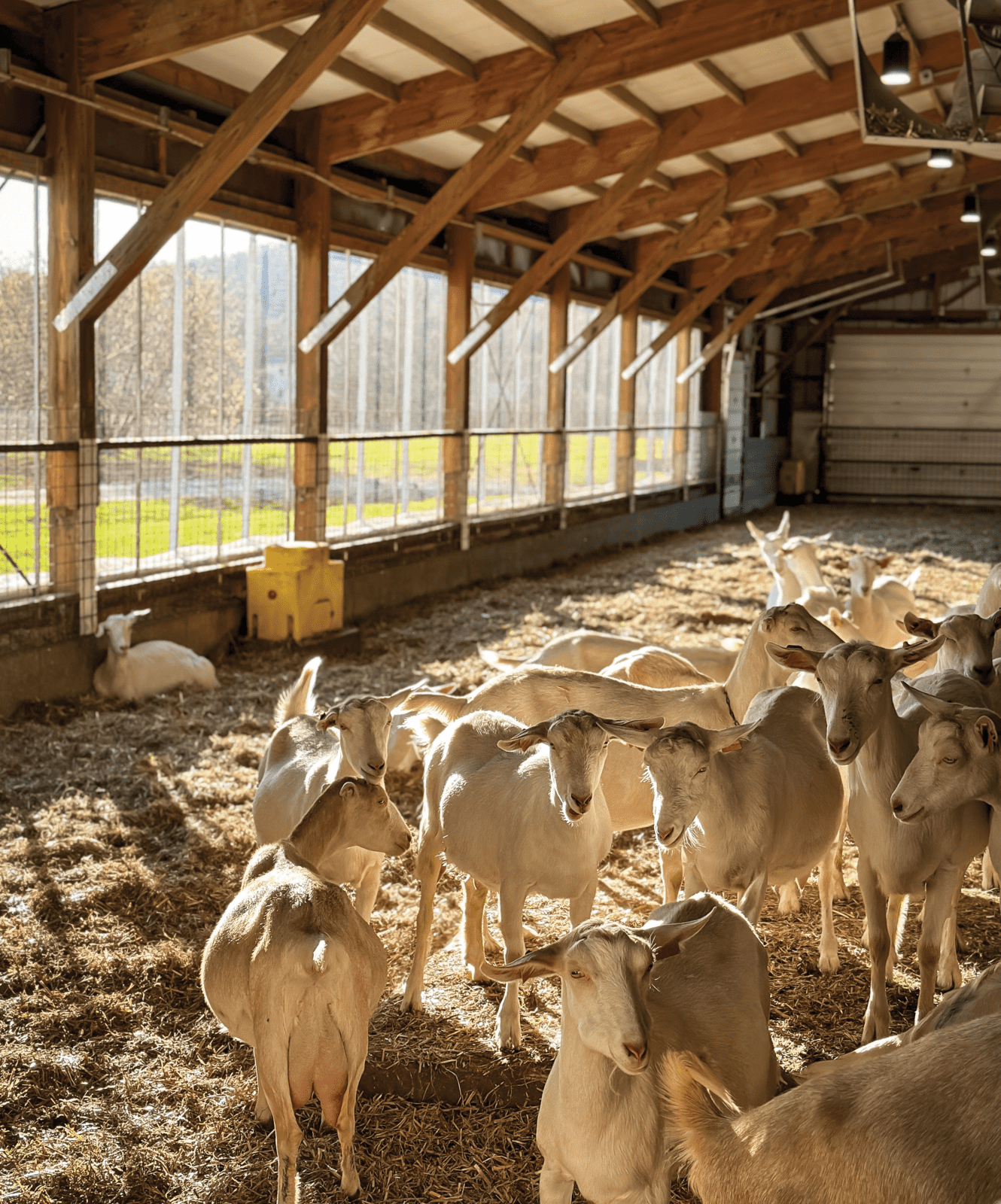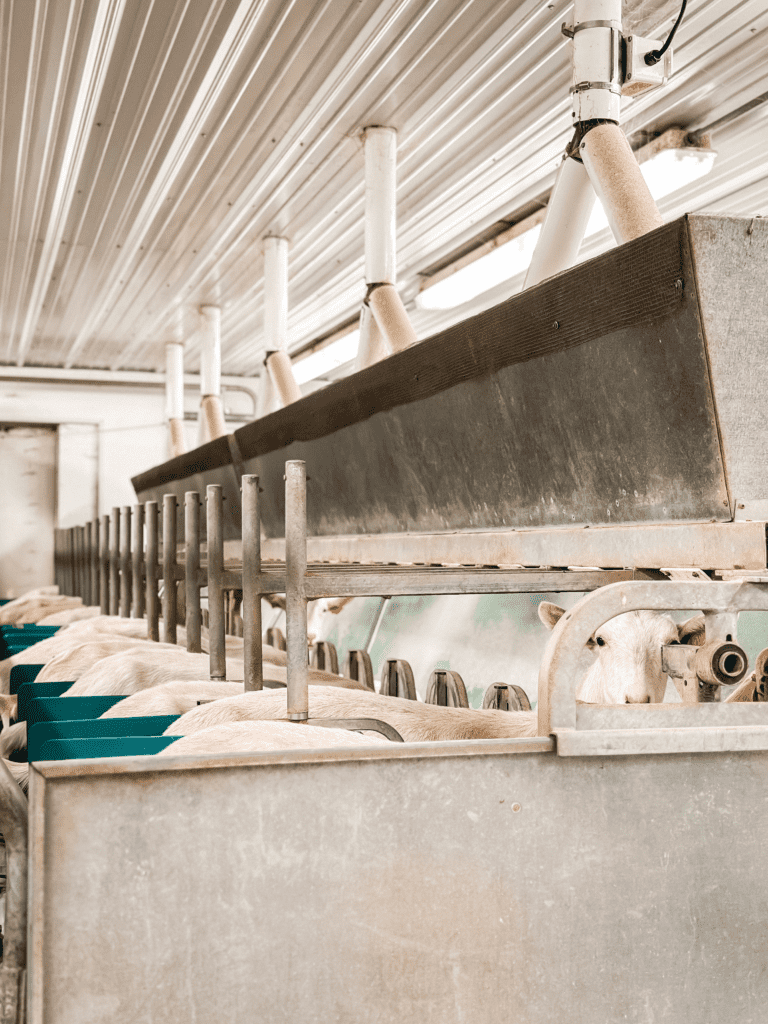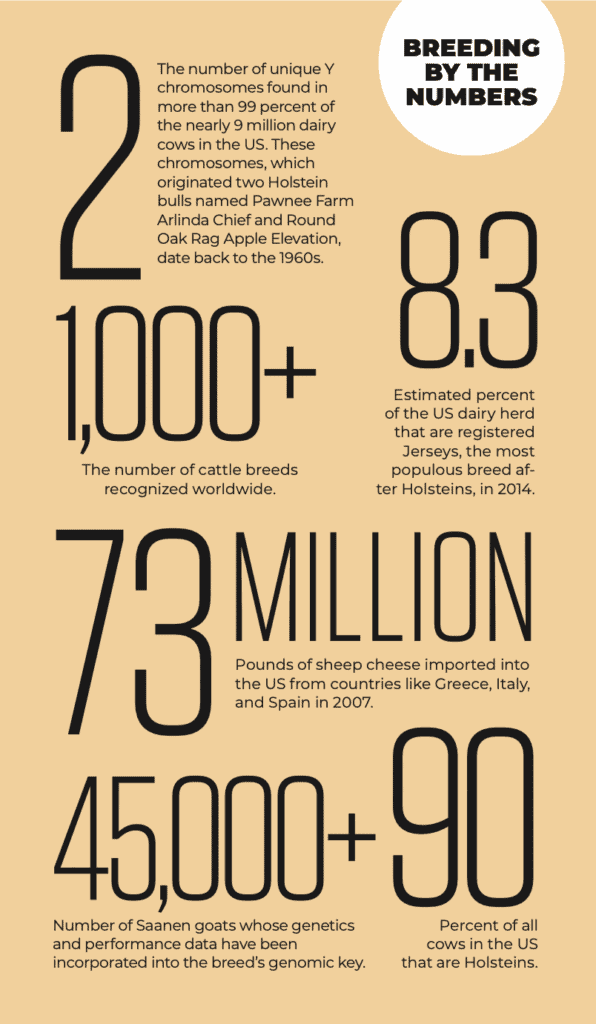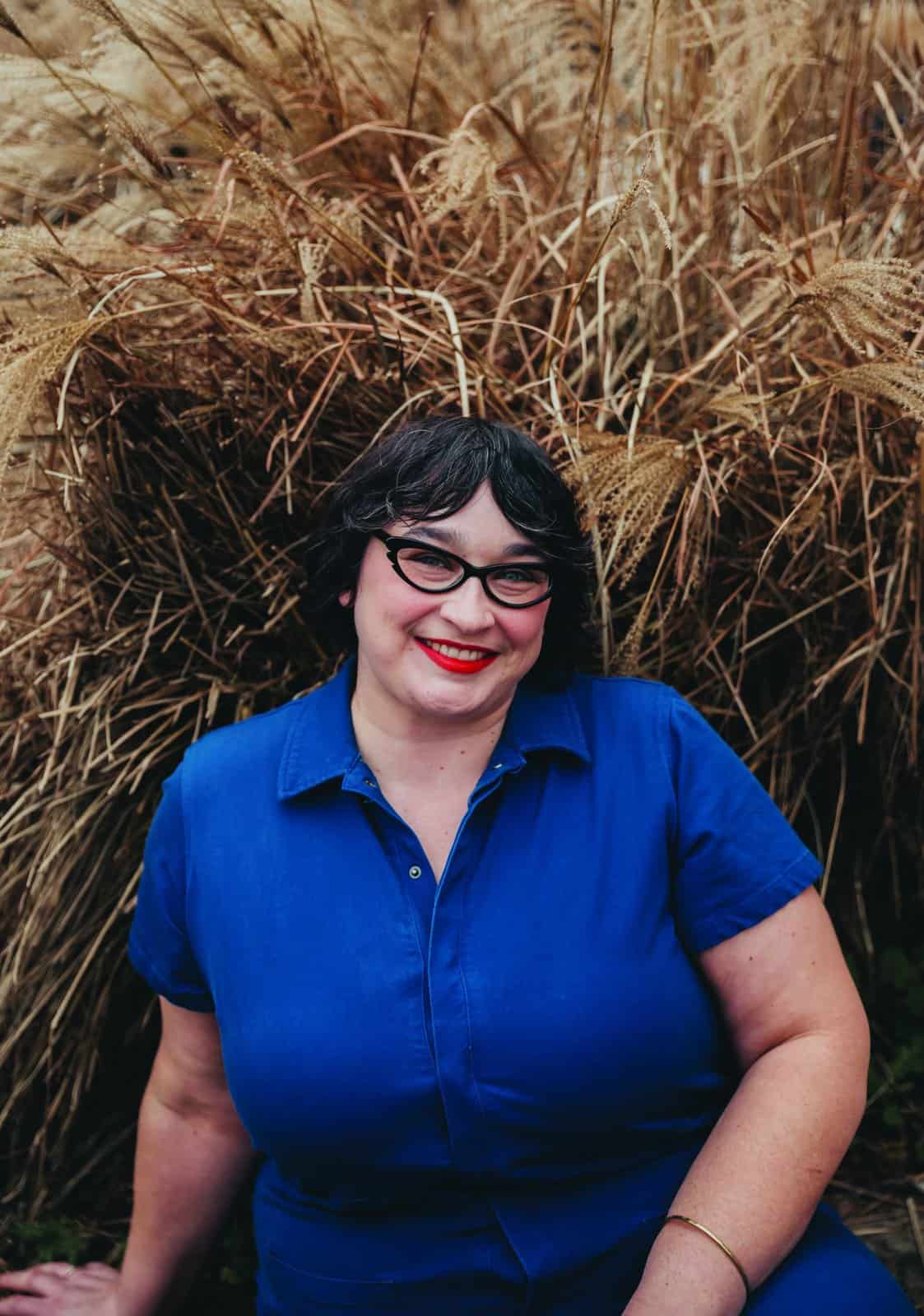
Photograph by Josie Krogh
Enterprising dairies blend the latest tech and age-old practices to raise healthier animals, strengthen farms, and produce top-quality milk
Miles Hooper dreams of the day he can milk his goats for two years straight.
Saanens—the breed Hooper and his wife, Daryll Breau, raise at Ayers Brook Goat Dairy in Randolph, Vermont—are recognized as the highest-producing goat breed in the world. Originally from Switzerland, with snowy white fur and pink-tinged ears and noses, the average doe can give milk for 150 to 300 days on a single lactation cycle.
But with intensive breeding backed by genetic data, Hooper hopes to double—or even triple—the length of that cycle. “We’ll see about a 720-day lactation for a lot of those goats, which is a step closer to where we want to be,” he says. “Ultimately, we want the average to be somewhere in the vicinity of 900 days.” He’s just one in a new generation of dairy farmers who have more information about their animals than ever—and who are using it to raise healthier herds, strengthen their businesses, and produce better milk for cheese.
Starting as a project for Vermont Creamery in 2012, Ayers Brook still sells milk to be made into the creamery’s soft-ripened cheeses such as Bonne Bouche and Coupole. When Vermont Creamery founders Allison Hooper (Miles’s mother) and Bob Reese sold to Land O’Lakes in 2017, Miles and Daryll bought back the farm. Now, they’re focused on a goal bigger than making great milk: creating a dairy goat unlike any the world has seen.

At Ayers Brook Goat Dairy, “every goat needs to make varsity every year,” says farmer Miles Hooper. “There’s no JV team, and you have to try out all the time.
That’s where Saanens come in. The breed’s genomic key is the most highly developed in the goat world, with the performance and genetic data of more than 45,000 animals. This information gives farmers unprecedented insight into how the offspring of their best cows, does, and ewes might perform when impregnated with the semen of a given bull, buck, or ram. Genomic selection has been common in dairy cattle breeding for more than a decade, but it’s newer in goat farming. “We know that the folks that were early adopters to genomics in the cow world have really excelled because of that,” Hooper says.
Humans have selected livestock for certain traits since the first species were domesticated more than 10,000 years ago. Landrace animals, uniquely adapted to local climates and landscapes, were bred for everything from heat tolerance to fiber quality to their ability to forage for food. It wasn’t until the eighteenth century that standardized breeds became commonplace. Farmers began breeding animals for certain physical characteristics standard to their breed, like size or color, and specialized purposes—milk, meat, draft, and fiber. This shift helped make animals and farms larger and more productive.
The development of artificial insemination (AI) in the 1930s and frozen semen in the 1950s continued this trend and made breeding a more technical, hands-off affair. Rather than raising or borrowing a bull to breed your cows the old-fashioned way, farmers could choose from the semen of pedigreed sires thousands of miles away. Still, it took years—until that cow had a daughter, and that daughter had her first calf—to see how well the desired traits had been passed down.


Today, keeping detailed records on metrics like milk volume, component levels, and how well animals conform physically to their breed can make these decisions easier, with more consistent results. And although breeding decisions must still be proven over time, genomic data gives farmers more confidence than ever before that their strategy is sound long before a new generation is born.
“One of the things that has held back the goat world for so long is that people have been indifferent to the power of collecting this information on their animals,” Hooper says. “That’s not an insignificant line item for us, but we firmly believe we couldn’t manage this farm without it.”
Breeding for desirable traits directly affects a dairy farm’s bottom line. Research is even underway to assess whether genetic data can help breed cows that emit less methane as a climate change mitigation strategy. Smart breeding can also create a herd whose members live longer, better lives: Pest and disease resistance and ease of kidding mean healthier animals. Breeding and pregnancy are stressors; complications giving birth, Hooper says, are a leading cause of mortality. Even that 900-day average lactation goal can benefit routine- loving livestock. “The steadier and more consistent we can keep things for the goats, the better they produce and the happier they are,” he says. “The less pregnancies that we can put them through for the same amount of milk, the better.”
By going big on genomics, Hooper also hopes Ayers Brook’s approach will appeal to cow dairies looking to diversify into goats. “We believe that the biggest opportunity for goats is not necessarily to attract new farmers into the business, but to help dairy farmers who are seeing a stagnant industry,” he says. “There’s at least growth in goat’s milk.”

Assaf ewes line up for milking time.
Halfway across the country, Mariana Marques de Almeida hopes that high-quality genetics and strategic breeding can give American sheep dairying a much-needed boost.
At Ms. J and Co. in Monroe, Wisconsin, the Portuguese-born animal scientist, breeding consultant, and cheese specialist raises 800 Spanish Assaf sheep. Before she and Maple Leaf Cheese store owners Jeff Wideman and Shirley Knox launched the company in 2015, they noticed immense market potential in the US, which is the top importer of sheep’s milk cheese in the world. “It was 33 million pounds of [sheep] cheese imported that year,” she says. “That’s more than two truckloads of cheese a day.”
European sheep cheeses like feta, Manchego, pecorino, and Roquefort are popular in the states, but consumers often don’t realize they’re sheep products. And until they were recently lifted, bans on importing sheep genetics into the US due to disease concerns inhibited farmers’ ability to improve their flocks. Currently, there are fewer than 200 sheep dairies nationwide.
“If we are looking at building local markets, we need to increase production here, and we need to use the tools that they have in Europe to produce cheese here.”
Assafs, known for high milk volume and fertility, were developed in Israel in the 1950s and have been selectively bred by Spanish breeders since the 1970s. Spanish Assafs are backed by robust genomic data, and they fare as well in Wisconsin’s freezing winters as they do in Spain’s Mediterranean climate. It’s Marques de Almeida’s hope that serving as a resource for small ruminant farmers and providing access to high-quality genetics can help make raising dairy sheep viable in this country.

Morgan Holes milking a sheep at Maple Leaf Cheese.
If high-quality genetics become easier to source, she believes, the barrier to entry and startup costs for would-be dairy sheep farmers will be much lower. Sheep are smaller, easier to handle, and require less feed than cows. Plus, sheep’s milk has significantly higher fat and protein compared to goat’s and cow’s milk, making it excellent for cheesemaking despite lower overall milk volume.
“If we are looking at building local markets, we need to increase production here, and we need to use the tools that they have in Europe to produce cheese here,” she says. “Maybe one day we can produce it at a lower cost than the imports.”
Even in the cow sector, where high-producing Holsteins makeup around 90 percent of the nation’s dairy herd, farmers are looking to other breeds—and unconventional breeding strategies—to boost farm viability, raise healthier animals, and make high-quality cheese. “Genetics and breeding are the reason we can farm where we are, with the heat and the humidity,” says Jessica Little, co-owner of Sweet Grass Dairy in Thomasville, Georgia.
She and her cheesemaker husband, Jeremy Little, run the family’s cheese business—Georgia’s first—and source milk from three pasture-based dairies run by her parents, Al and Desiree Wehner, and brother her Clay. But raising animals on pasture for cheesemaking in their particular climate took time to figure out.
The Wehners ran a 2,000-cow conventional dairy in Florida until 1993, when they decided to relocate to South Georgia with 500 of their best animals, and transition to rotational grazing. They soon learned their Holsteins were ill-suited to grazing outdoors in the hot, humid South. They consulted with old timers in the area—what breed did their grandfathers raise?

Sweet Grass Dairy’s mixed-breed herds have the genetics to thrive on grass in south Georgia’s hot, humid climate.
“In the early ’90s, nobody wanted Jerseys because they gave you so little milk that it wasn’t worthwhile. You couldn’t afford to feed them for the amount you would get back. But in this rotational grazing style, it was perfect,” Little says. “The milk tasted so different, which is the reason Sweet Grass exists.”
The Wehners, who both have degrees in animal science, decided to create
a cow that would thrive on their farm. That meant breeding for milk rich in fat and protein longevity—a cow that could have 12 to 15 lactations in a lifetime rather than two or three—and short, strong legs that could handle frequent walks from the pasture to the milking parlor. They’d need wide muzzles to pick up lots of grass with each bite and large rumens to digest it. Plus, good heat tolerance and fertility, and the now-desirable A2A2 protein. They mixed in breeds like Normande, Limousin, heat-adapted Senepol, and even Holstein and Friesian to ensure sufficient volume.
“After 30 years, my parents have figured out that the cow that works in our system in South Georgia is never going to win any beauty contests,” Little says, “but they’re going to live really long lives, give really high-quality milk, and have a higher breed back rate.”
That last detail is important. For the past seven years, the Wehners have chosen to forgo artificial insemination, which often relies on artificial hormones to put cows in heat and can take a toll on workers’ bodies. Instead, they breed their animals naturally, keeping young genomic bulls that are easier to handle on the property for a few years before selling them to other farms. They save by purchasing sires that fit their needs but cost much less than prizewinning studs. And while AI insemination rates can average between 50 and 70 percent, the Wehners have been able to breed back as many as 90 percent of their cows during their ideal calving window—meaning fewer culls, healthier calves, and a long list of dairies waiting to purchase their robust, regionally adapted animals.

All this has translated into better profitability and quality of life—for the farms, the animals, the family, and the cheese business, too. “I want the highest-quality milk that they can produce, that they feel happy with, and that is sustainable in the long run,” Little says. “My brother’s going to be happy, the cows are going to be happy, the land is going to be healthy, and then we’re going to have great milk to make great cheese.”




